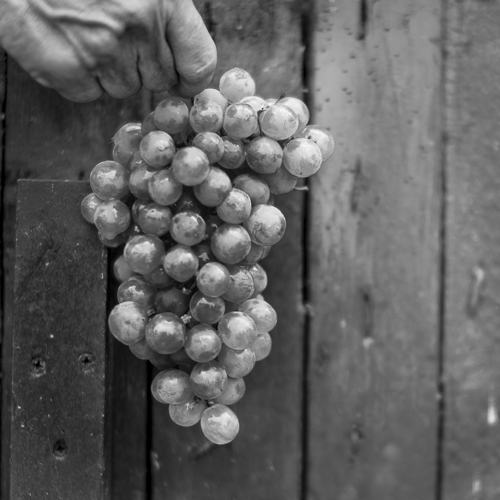We visited this farm where one brother, Marco, runs the farm, while the siblings Mara and Maurizio are running the guesthouse.
On an area of about 30 hectares of fertile soil, vineyards of white grapes: Vermentino and Ansonica, and a red one: Sangiovese are located between hills covered by Mediterranean macquis.
Having arrived during the harvest of Vermentino , we could watch Marco driving a tractor very slowly between two rows of vines, while two workers were standing on a carriage mounted at the back of the tractor. As they passed plastic cases full of juicy grapes, the workers put the cases on the carriage in rows and columns.
In the meantime, we walked along a row where workers were busy collecting grape clusters. First, they cut the stem of the cluster with pliers, next they let it fall into a plastic case. They repeated this procedure until the case was full, then they started filling another one.
After some time, the carriage was fully loaded with cases of grapes, meaning it was time to return to the wine cellar next to the traditional farmhouse, which has been turned into a guesthouse.
Having reversed the tractor such that the carriage was located next to a an open metal container with an Archimedean screw at its base. The workers let the grape clusters fall into the container where the Archimedean screw was continually rotating, forcing the grapes to enter a chamber where they were de-stemmed. While the stems were excreted into a box lying below the machine, the grapes were crushed and the juice was pumped into large steel containers in the wine cellar.
Since Vermentino is a white wine, the must is separated from the skin and the seeds in order to avoid extracting the tannins occurring in the solids. Yeast may be added to the must and in the tranquillity of the container a metamorphosis is occurring: the yeast starts the process of fermentation where the sugars in the grapes are turned into alcohol.
When all the cases had been emptied into the machine, the workers would put them back on the carriage and Marco would drive back to the vineyards where the empty cases would be unloaded, while the the full ones would be transported to the machine for de-stemming and crushing.
When the Vermentino harvest would be finished, Marco and the workers would start harvesting Sangiovese. Contrary to production of white wines, the skin and the seeds of red wines are pumped into steel containers together with the must. In this way, the colour pigments and the tannins present in the skin of the grape, are passed to the must.
As regards renewing the grapevines, it’s common to buy them at nurseries. They become productive after about five years and enter their prime when they are 8 years and they keep on producing at a high level at least until they are 20 years old. However, they can be productive for many more years. For instance, a wine farm I visited in Piemonte had vines dating from 1928!
In between some of the rows of grapevines, there were rows of leccino olive trees, all in all about 1000 trees. The row of vineyards and olive trees together with the verdant hills surrounding the fields created a wonderful mix of greens, adding aesthetic value to the fertility of the land.
According to this web site, this is a tradition which has been practised in the Mediterranean region for millennia. The olive trees shelter the vineyards somewhat against wind, but the most important is that as the wine harvest ends in September-October, the olive harvest begins. Thus, the farmer can let the same workers who have been harvesting grapes go on to harvest olives.
This land is rich in sandstone and pebbles, making the soil very suitable for growing grapevines and olive trees because the plants get enough nutrients from the soil and it’s able to absorb large amounts of rain. In addition, between the verdant hills of Argentario and the lagoon, the microclimate is perfect for a sound growth of the plants. They are protected against winds from the south-east because of the surrounding hills, while sea breezes from the north serve to give a well-balanced growth of the grapes.

